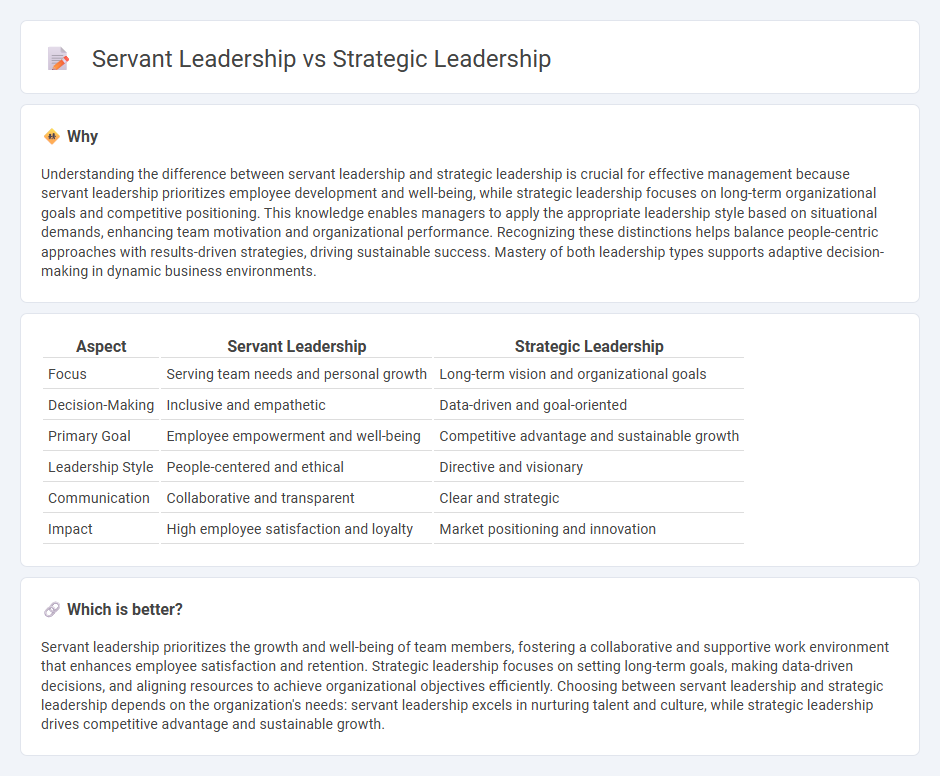
Servant leadership emphasizes prioritizing the needs and growth of team members to foster a supportive and collaborative work environment, focusing on empathy, stewardship, and community building. Strategic leadership, on the other hand, drives organizational success through vision, planning, and resource management to achieve long-term goals and competitive advantage. Explore the distinct approaches and benefits of servant versus strategic leadership in effective management.
Why it is important
Understanding the difference between servant leadership and strategic leadership is crucial for effective management because servant leadership prioritizes employee development and well-being, while strategic leadership focuses on long-term organizational goals and competitive positioning. This knowledge enables managers to apply the appropriate leadership style based on situational demands, enhancing team motivation and organizational performance. Recognizing these distinctions helps balance people-centric approaches with results-driven strategies, driving sustainable success. Mastery of both leadership types supports adaptive decision-making in dynamic business environments.
Comparison Table
| Aspect | Servant Leadership | Strategic Leadership |
|---|---|---|
| Focus | Serving team needs and personal growth | Long-term vision and organizational goals |
| Decision-Making | Inclusive and empathetic | Data-driven and goal-oriented |
| Primary Goal | Employee empowerment and well-being | Competitive advantage and sustainable growth |
| Leadership Style | People-centered and ethical | Directive and visionary |
| Communication | Collaborative and transparent | Clear and strategic |
| Impact | High employee satisfaction and loyalty | Market positioning and innovation |
Which is better?
Servant leadership prioritizes the growth and well-being of team members, fostering a collaborative and supportive work environment that enhances employee satisfaction and retention. Strategic leadership focuses on setting long-term goals, making data-driven decisions, and aligning resources to achieve organizational objectives efficiently. Choosing between servant leadership and strategic leadership depends on the organization's needs: servant leadership excels in nurturing talent and culture, while strategic leadership drives competitive advantage and sustainable growth.
Connection
Servant leadership and strategic leadership intersect through their shared focus on empowering individuals and fostering long-term organizational success. Servant leadership emphasizes prioritizing employees' growth and well-being, which cultivates a motivated workforce essential for executing strategic goals. Strategic leadership leverages this foundation by aligning team efforts with the organization's vision, driving effective decision-making and sustained competitive advantage.
Key Terms
Vision
Strategic leadership centers on setting a clear, long-term vision to guide organizational growth and competitive advantage, emphasizing decision-making and goal alignment. Servant leadership prioritizes serving others and fostering a supportive environment that encourages shared vision and collective growth. Explore the nuances of these leadership styles to understand their impact on vision development and execution.
Empowerment
Strategic leadership emphasizes aligning organizational goals with long-term vision, empowering teams by setting clear objectives and fostering decision-making autonomy. Servant leadership prioritizes the growth and well-being of team members, enhancing empowerment through active listening, empathy, and support for individual development. Explore more about how these leadership styles uniquely cultivate empowerment in diverse organizational environments.
Stakeholders
Strategic leadership concentrates on aligning organizational goals with long-term stakeholder interests, emphasizing vision, innovation, and competitive advantage to create value for shareholders, customers, and employees. Servant leadership prioritizes the needs and development of stakeholders by fostering trust, empathy, and collaboration, promoting a culture of empowerment and ethical decision-making. Explore the nuances and benefits of both leadership styles to enhance stakeholder engagement and organizational success.
Source and External Links
What is Strategic Leadership? - Bentley University - Strategic leadership focuses on long-term vision and direction, helping organizations navigate change, drive innovation, sustain competitive advantage, and build resilience by aligning resources and capabilities with strategic goals.
What is strategic leadership? | Definition from TechTarget - Strategic leadership involves executives crafting a vision and strategy that enables the organization to adapt, innovate, and compete effectively by motivating employees and streamlining processes.
How to Become a Strategic Leader | CCL - Strategic leadership is broad, future-focused, and change-oriented, requiring leaders to make sense of complexity and guide their organizations through interdependent decisions while balancing short-term and long-term goals.
 dowidth.com
dowidth.com